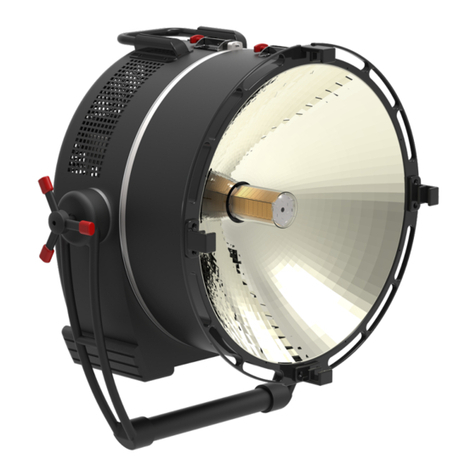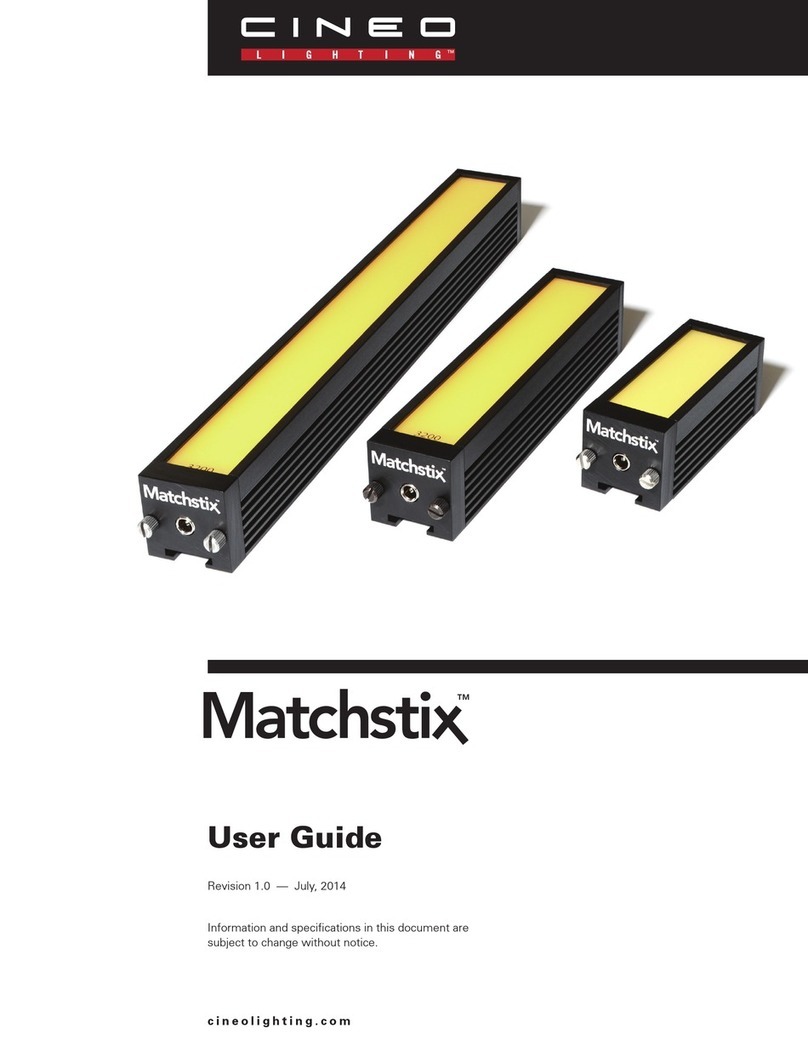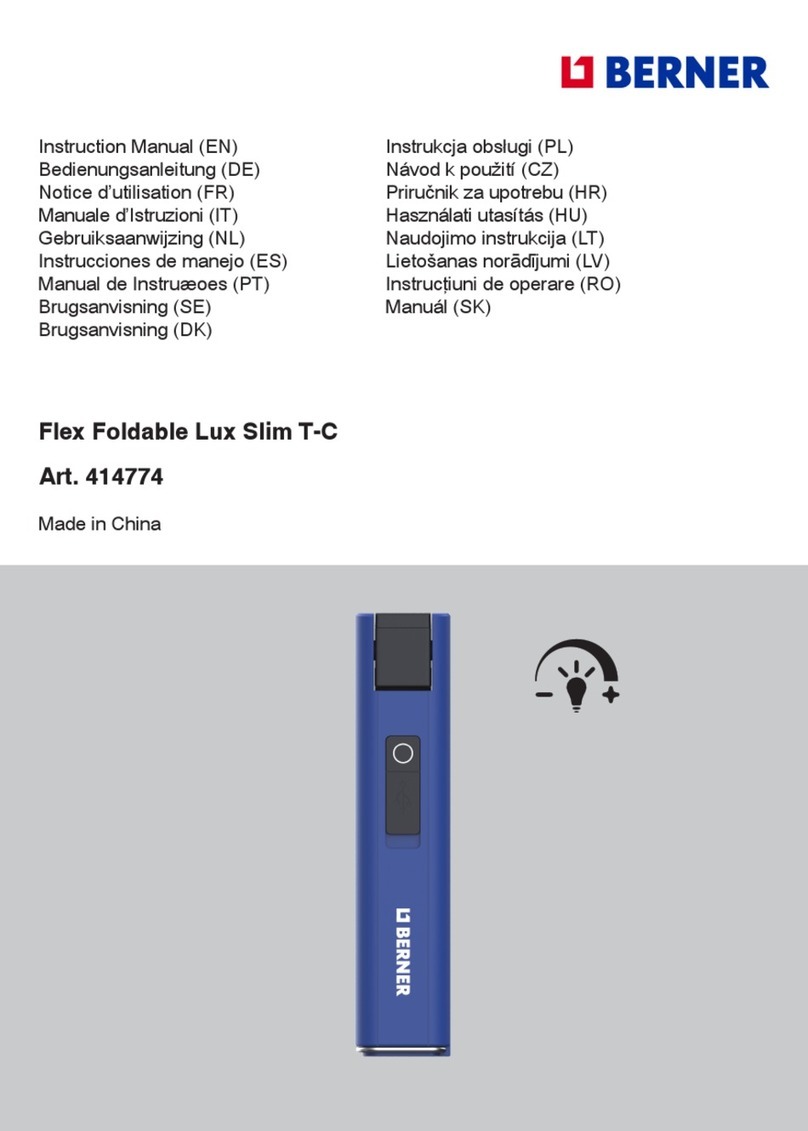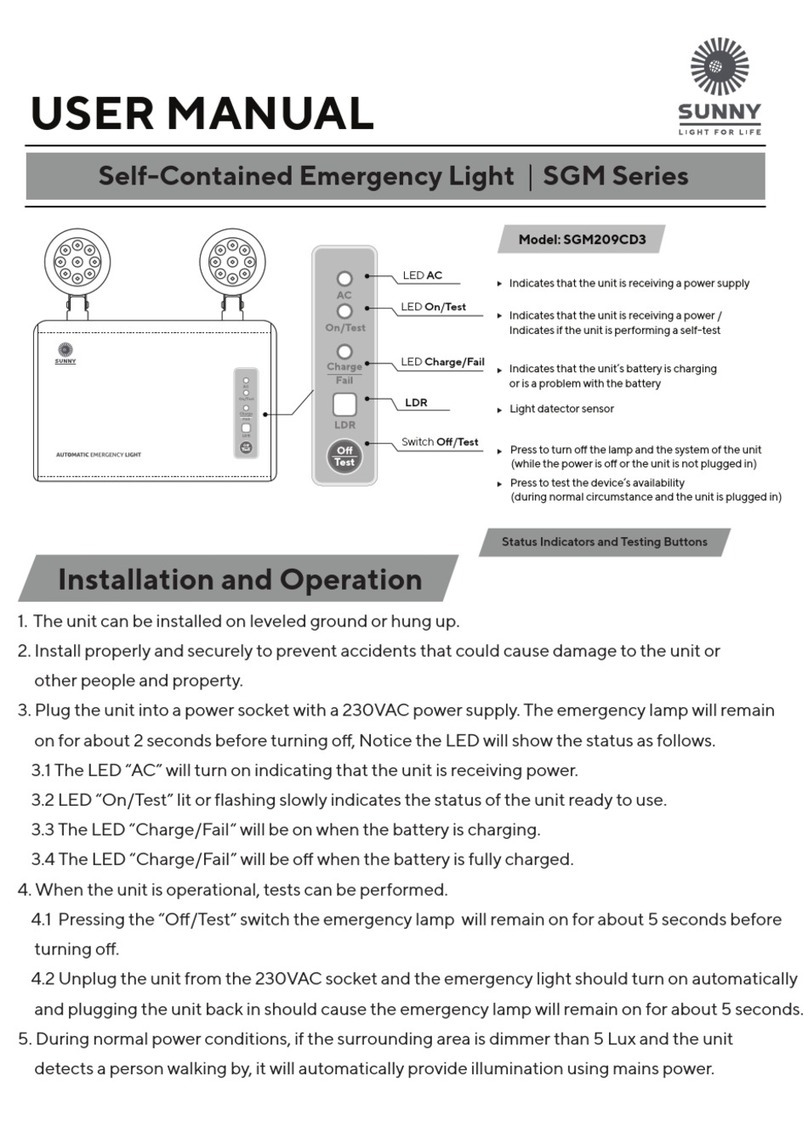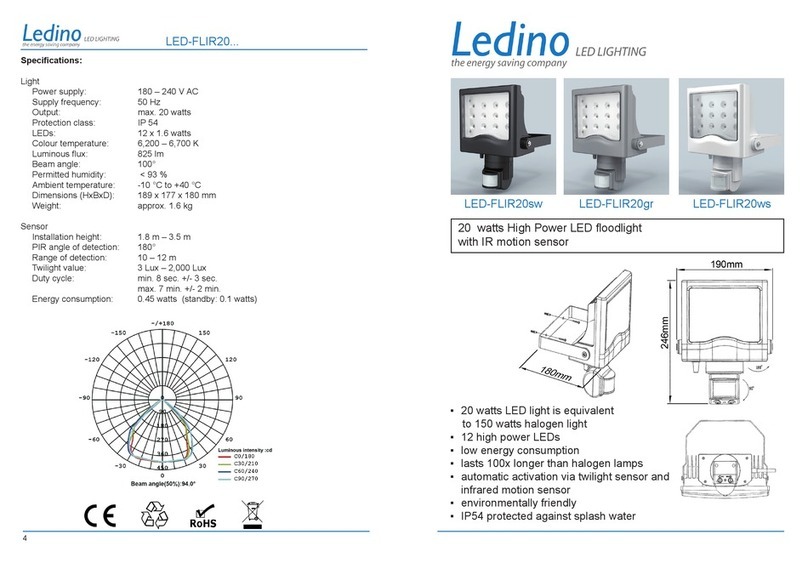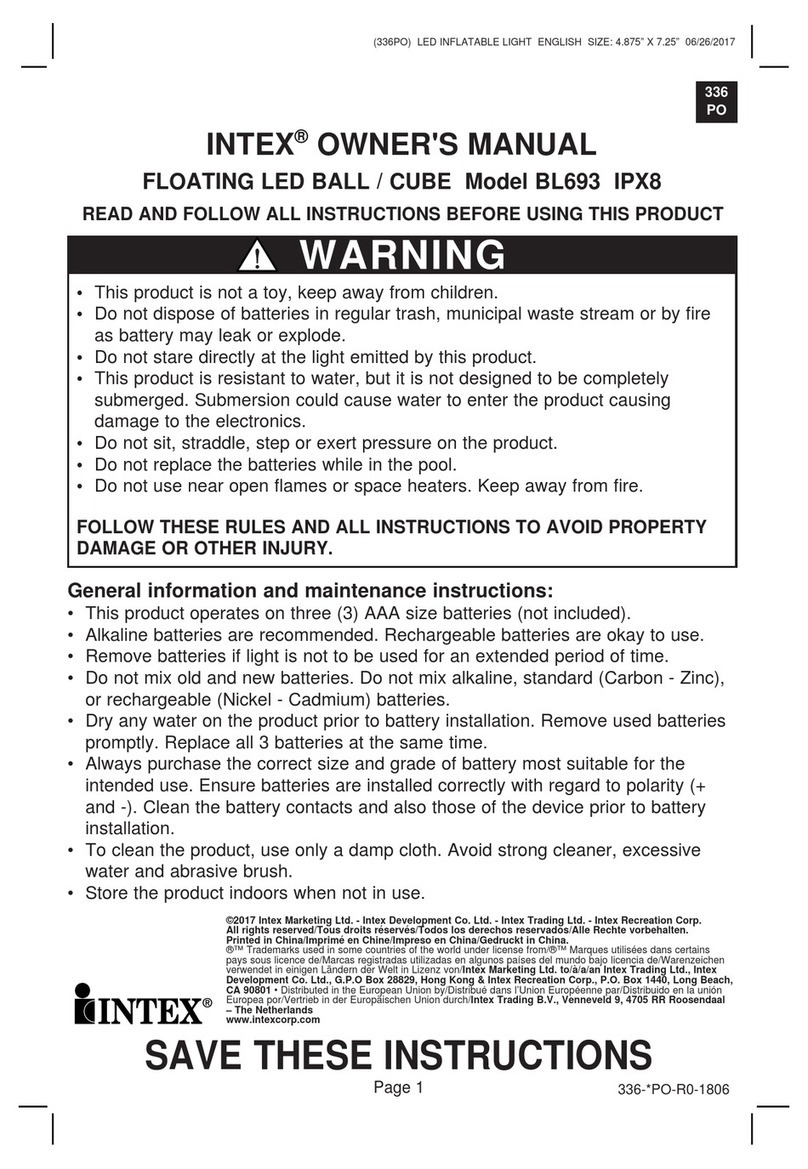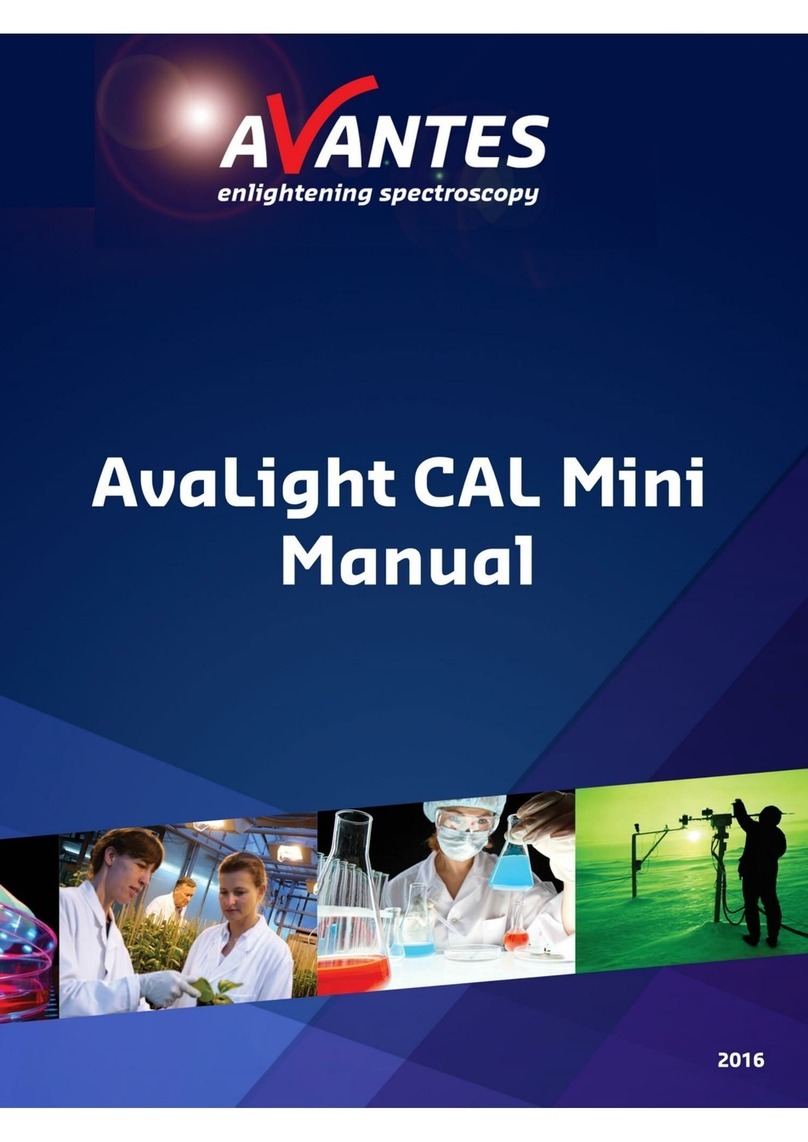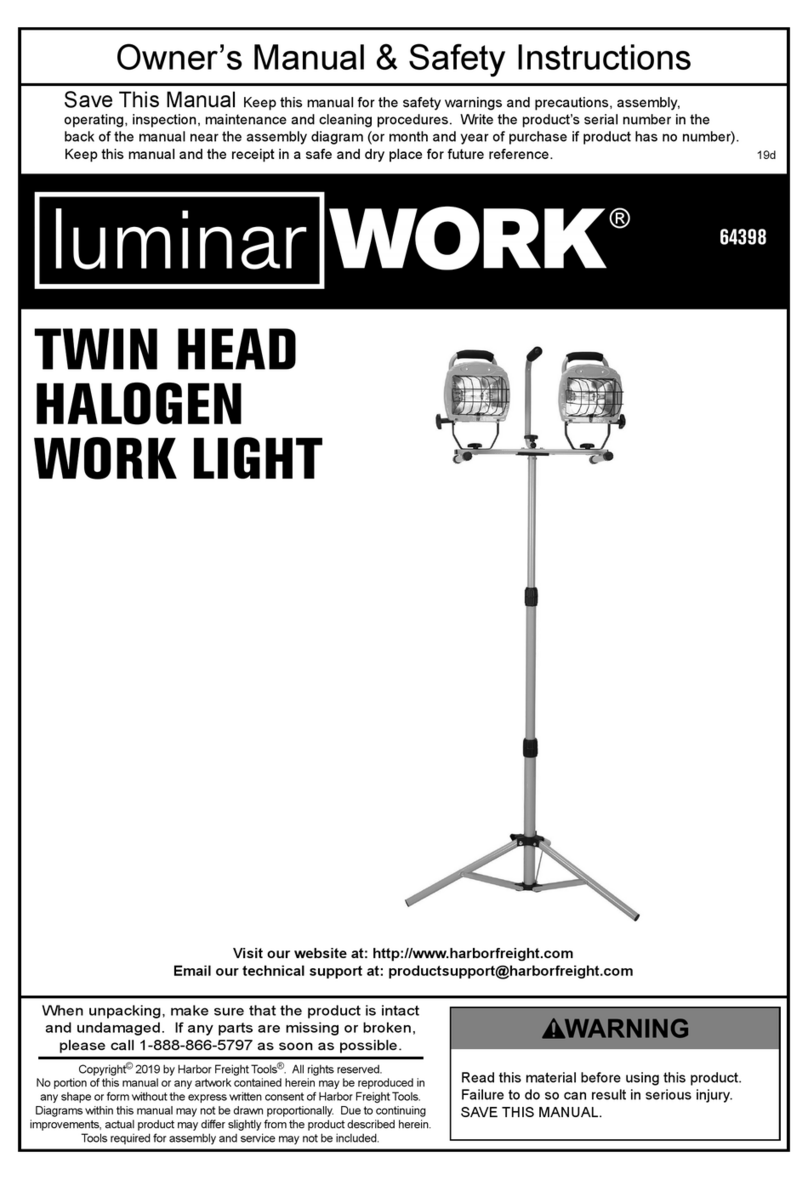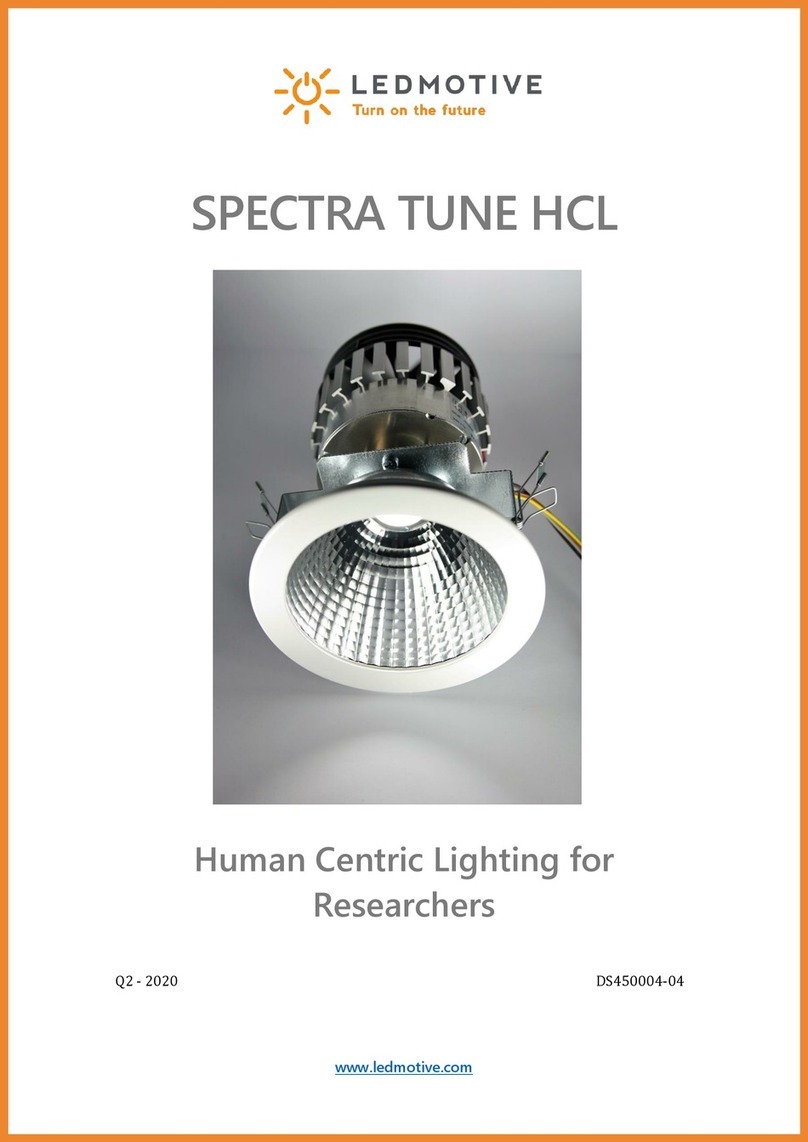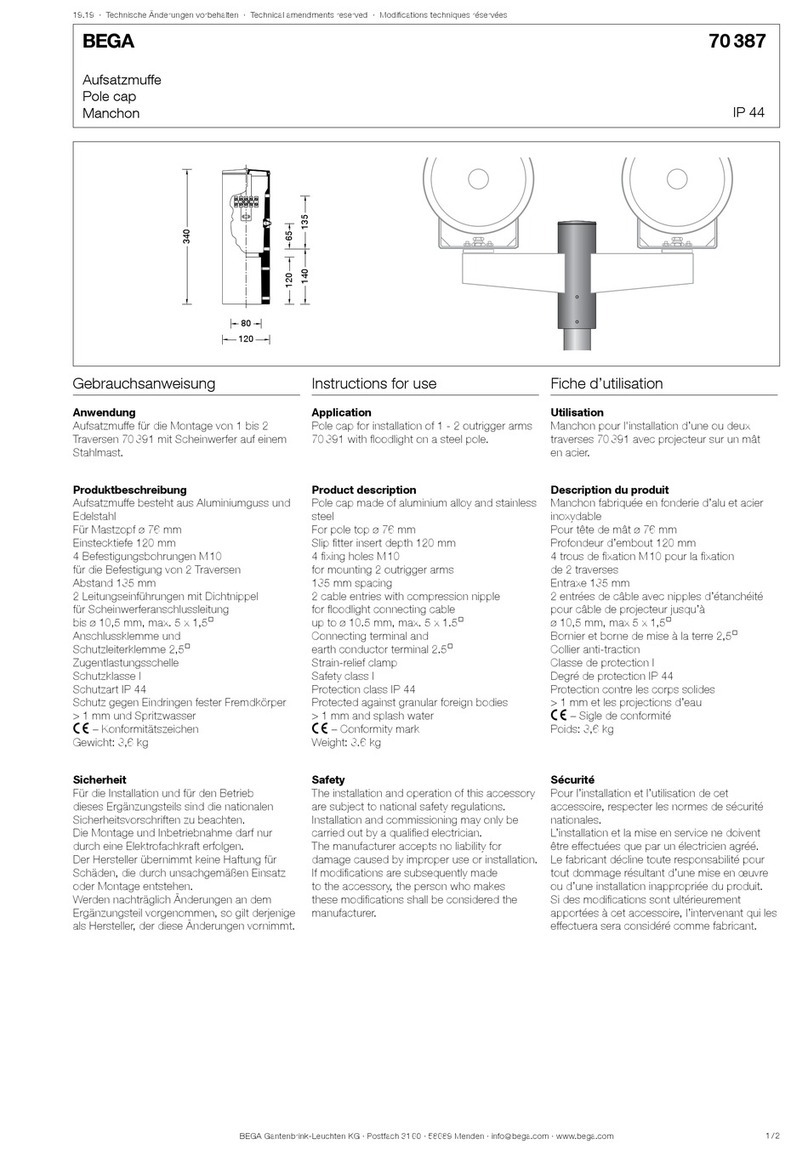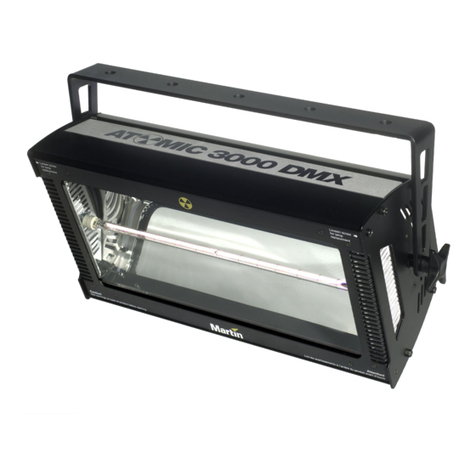Cineo Standard 410 User manual

User Guide
Revision 2.2 — August, 2018
Information and specications in this document are
subject to change without notice.
www.cineolighting.com

2
Cineo has designed the ultimate creative lighting
tool: the Standard 410. Combining the same
award-winning white light quality used in Cineo
HSX with innovative saturated color technology,
the Standard 410 delivers up to 25,000 lumens of
beautiful, easily controllable, full-gamut light across
a diused 1’ x 2’ aperture. With built in power
supply and silent operation, the Standard 410
delivers 410 watts of power in a package that is
less than 30 lbs and is less than 5 inches deep.
Creating beautiful white light with extended color
gamut in smart packaging is only part of the story.
Cineo has also developed an intuitive control
strategy that allows predictable, repeatable results,
either using the graphic on-board control panel or
remotely with wired DMX/RDM or built-in wireless
CRMX control.
The Standard 410 is ruggedly built and passively
cooled for completely silent operation. The
Standard 410 also includes an integrated power
supply for easy setup.
The strategy for control is simple. Whether using
local or DMX settings, four independent controls
(DIM, CCT, SATURATION and HUE) give range to
the entire xture via a single mode of intuitive
operation.
Dim
Uniform Control of Total Fixture Output.
Cineo’s Photo-Accurate Dimming™ maps the
0-100% dimming curve to actual camera stops
for precise output control using the DIM control
locally or on the 1st DMX channel.
CCT
Adjust Primary White Light Base 2700-6500K.
For color-accurate white light, choose the CCT
by using the lower right rotary control or the 2nd
DMX channel.
Saturation
Blend Between White Light Base and the Color
Gamut. This control blends and balances the
amount of saturated color with the CCT base, from
pristine white to deep artistic color. The saturation
can be controlled remotely on the 3rd DMX
channel.
Hue
Explore Brilliant Color Palettes Across the Full
Color Space. To optionally add saturated color,
the HUE control adjusts added RGB. The hue can
be adjusted on the 4th DMX channel. The selected
hue is displayed on the control panel.
With Standard 410, the CCT, SATURATION and
HUE controls are mutually exclusive, allowing for
consistent color shading across the entire range of
white light bases. For example, +2 Green added to
3200K CCT will look the same as +2 Green at 5600K
to the correctly white-balanced camera.
In addition to Cineo’s proprietary phosphor-
converted white light LEDs, we have developed
phosphor-converted saturated color LEDs. The
phosphor-converted LEDs use the exact same dies
as the white LEDs, ensuring that all light emitting
elements of the Standard 410 carry identical
thermal stability and perform over time with
identical dierential aging. After years of service,
Cineo’s color stability remains consistent.
Welcome to Standard 410 from Cineo

3
General Notes
1. Please read through this manual carefully before operating Cineo Standard 410, and keep this manual
for future reference.
2. There are numerous safety instructions and warnings that must be adhered to for your
own safety.
3. Standard 410 is not intended for residential use. It is intended for use in a professional studio.
4. Standard 410 must be serviced by a qualied technician.
5. The Cineo Standard 410 is rated as IP22 – for damp environments.
6. Cineo products are not certied for use in hazardous locations.
Fixture Set Up
Read these safety instructions carefully to ensure xture and accessories are used safely.
Ensure the TVMP adapter is correctly mounted onto the yoke before rigging.
Always use secondary safety cables of suitable length when hanging Cineo Standard 410 units.
The Standard 410 weighs 28 lbs. (12.7 kg) excluding accessories. The combined weight should be
considered when choosing a suitable safety cable.
Safety cables must securely be attached to the yoke on Standard 410 and should be as short as possible
to reduce travel distance if primary hanging accessory fails.
Ensure that the yoke lock is correctly tightened when manipulating Standard 410 in the required
orientation for safety purposes.
Ensure the Cineo Standard 410 is operated within an ambient temperature range of -20 to +40°C
(-4 to 104°F).

4
System Components, Connections and Controls
All connectors and system controls for the Cineo Standard 410 are located on the back of the unit. In
addition to its full color heads-up display, optically encoded rotary knobs give access to menu selections
and local control inputs. Hard power connections and switches allow for easy set up and strike. The 5 pin
DMX connections, embedded wireless receivers, RDM responders, and powered USB ports support many
options for external control.
Front
DMX
Connectors
USB Port
AC Power In, Fuse
and Power Switch
Back

5
Power
The Standard 410 unit is controlled by an internal power supply. 110 – 220VAC is provided to the unit via
a locking IEC connector, located on the back control panel.
NOTES:
1. Ensure the power cable is disconnected before servicing.
2. Do not connect to a variable supply, such as a dimmer rack.
3. The power cable should be plugged into the power supply before switching the power ON. The power
supply should be switched OFF before removing the power cable.
4. A fuse is located within the IEC connection port. A spare fuse is provided in this same space. If power
is provided, the power switch is ON and the LED light on the power switch is not illuminated, please
disconnect power and check this fuse rst.
Displays Screens
The Standard 410 control interface includes two backlit displays, each of which communicates valuable
yet discrete information during the operation and setup of the Standard 410. They are separated as
CONTROL and STATUS.
Control Screen
The Control screen is an 8-character, daylight-visible
display that shows data adjustment values in Local
Mode, shows DMX signal status in DMX Mode,
Radio status, and interacts with the Status screen in
Menu Mode.
Status Screen
In Local Mode, the full-color screen displays the status
of each DIM, CCT, SATURATION and HUE control value.
The color ribbons on the top and bottom of the display
give a visual reference for both the CCT and the HUE.
DIM value and SATURATION are represented as a
percentage. In DMX mode, this display reects the
current DMX channel assignment as well as the current
Personality and communication bitrate.

6
Color Space
The Standard 410 uses two separate LED engines
to independently generate accurate white light,
variable from 2700K to 6500K, and an extended
RGB gamut for broad saturated color space.
The CIE 1931 diagram opposite illustrates the
Standard 410 color space.
Controls
Setup of the Standard 410 is can be accomplished either using the large knob with the CONTROL and
STATUS displays, or remotely using RDM.
Standard 410 Setup Menus
Operational parameters for the Standard 410 are managed through the Setup Menus.
The Setup Menus can be enabled via the control panel as follows:
1. Push and hold the large knob for approximately 3 seconds. The status display will now show the root
menu.
2. Turn the large knob until the desired control selection is highlighted: LOCAL, DMX, PRESETS or
SETTINGS.
3. Push the knob again to select menu category.
*Note that in any menu, pressing and holding the large
knob for 3 seconds will return you to the root menu.

7
LOCAL Mode
When LOCAL mode is selected, all functions of the xture
are managed through the 4 rotary encoders; feedback and
functions are displayed on the display screens. The Control
Screen contextually switches to show the value of each
control being adjusted.
Lower left knob (Large) Photo-Accurate Dimming
The dimming curve on the Standard 410 follows a strategy
that provides relative output levels that correspond to image
capture. Both DMX values and local control levels directly
correlate to camera stops in a meaningful way. The result is
extremely predictable light levels within the full output range
of the xture.
0-100% dimming is controlled by turning the large knob.
Pushing the knob cycles the output at these levels: 20%, 40%,
60%, 80% and 100%.
The following table shows the relationship between LOCAL values as they relate to camera stops:
Local Value % Output increase Stop Increase
(0-100)
20% 100 0
40% 200 1
60% 400 2
80% 800 3
100% 1600 4
Here are examples of how to accurately match camera stops to dimming levels in Local Mode:
Local Dimming: The Rule of 20 (0-100 scale)
Increase output 1 Stop: Add 20 units (fc/lux is doubled)
Decrease output 1 Stop: Subtract 20 units (fc/lux is reduced 50%)
Adjust ½ Stop = 10 Units (0-100)
Adjust ¼ Stop = 5 Units (0-100)

8
Lower right knob: CCT Adjustment
The color temperature (CCT) of the xture is controlled by turning the lower right knob in a continuously
variable range of 2700K to 6500K. Pushing the lower right knob cycles the CCT of the xture between
popular settings: 2700, 3200, 4300, 5600 and 6500K.
Upper left knob: Color Saturation
The SATURATION of color added to the base white light is controlled by the upper left knob, which has
presets at 0%, 10%, 20%, 50%, 80% and 100%. Note that the addition of saturated color does not change
the base CCT of the white light; these are completely independent functions.
Upper right knob: Hue Control
The upper right knob adjusts the saturated color hue, in 256 increments, and the approximate hue is
displayed on the color ribbon. Pushing this knob cycles between the primary and secondary colors: Red,
Yellow, Green, Cyan, Blue and Magenta. Colors can be ne-tuned anywhere within the color space.
The Status display shows all values selected for these four controls at all times.
DMX Mode
When DMX is selected from the root menu, operation of
the xture is controlled remotely on four DMX addresses
in the address range of 001 to 512. Also, various bit rate
and DMX Personality parameters can be selected for the
remote operation of the unit. To continue to change the
DMX parameters, select DMX SETTINGS and push the knob;
otherwise select KEEP SETTINGS to return to the previous
menu.
If DMX SETTINGS is selected, the menu shows dierent
DMX personalities that the xture can operate with: 8-bit
HSI, 16-bit HSI, 8-bit RGB and 16-bit RGB. The following
further explains:

9
8-BIT vs 16-BIT
Standard DMX data structure is 8-bit, which limits
the value range between 0-255. This is the preferable
operating mode for maximum compatibility with DMX
controllers. If more precise control is required, the unit
can be operated in 16-bit mode, oering a value range
of 0-65,535. On the surface, this sounds more valuable
than 8-bit mode, however operating in this mode
assigns two DMX channels for each control, working
in pairs, requiring twice as many DMX addresses. The
rst DMX channel in the pair is the COURSE adjustment
of the control, while the second channel is the FINE
adjustment. The COURSE channels operate identically to
8-bit controls, while the FINE channels in the pair adjust
in-between adjacent values of the COURSE control. To
further explain, the COURSE channel adjusts values of
0-255 while the FINE channel adjusts between only two
control values. If, for example the COURSE channel is set at value 165, the FINE channel adjusts between
165 and 166. Fortunately, most professional lighting consoles allow controls to be set up in 16-bit mode,
so a single fader manages the two channels automatically. It is recommended that 16-bit mode only be
used when the DMX controller supports 16-bit operation.
HSI vs. RGB Personality modes
HSI, also known as HSIK, stands for Hue, Saturation, Intensity and white value in Kelvin. This is the most
common method of control for full-gamut lighting xtures, and mimics the operation from the LOCAL
control panel on the back of the xture.
In HSIK Mode, the channel assignments are as follows, and are directly related to 8-bit or 16-bit operation:
First Channel (or channel pair for 16-bit): Output level
Second Channel (or channel pair): CCT
Third Channel (or channel pair): Color Saturation
Fourth Channel (or channel pair): Hue
The RGB Personality is technically considered RGBK, where a variable white point can be selected as
well as values of the primary Red, Green and Blue channels. This is extremely valuable in correlating RGB
operation in context with the white balance selected on the camera.
In RGBK Mode, channel assignments are as follows:
First Channel (or channel pair for 16-bit): RED level
Second Channel (or channel pair): GREEN level
Third Channel (or channel pair): BLUE level
Fourth Channel (or channel pair): CCT

10
For example, if all values of Red, Green and Blue are equal, the resultant white light emanating from the
xture will be at the CCT determined by the CCT control. In actuality, the Standard 410 correlates the RGB
values in combination with the white LEDs to maintain a very accurate, high-CRI white light value. Equal
values of Red, Green and Blue, each at 50% are the equivalent of a white light dim level of 50%.
DMX Address
Once a DMX Personality is selected, the large knob is used to set the master DMX address for dimming.
The other three controls are automatically addressed sequentially. The Control Display shows the master
address of the xture while the addresses are being selected, while the Status display show the address
range being assigned to the xture, based on the Personality selected. When the desired master address
is selected, push the large knob to save and enter DMX mode. The master address is shown on the Status
Display, along with the selected Personality. Both screens show the status of the DMX signal: DMX LINE,
DMX WIFI or DMX NONE.
Cineo PAD™ Dimming
As mentioned earlier, Cineo xtures use a Photo-Accurate Dimming curve, which oers light output
congruent with lens stops on a camera. When operating in DMX mode, each increase of 50 units (8-bit)
doubles the light output, or the equivalent of opening the lens 1 f-stop.
DMX Value % Output increase Stop Increase
(0-255)
50 100 0
100 200 1
150 400 2
200 800 3
250 1600 4

11
Here are examples of how to accurately match camera stops to dimming levels in DMX Mode:
DMX Dimming: The Rule of 50 (0-255 scale)
Increase output 1 Stop: Add 50 DMX values (fc/lux is doubled)
Decrease output 1 Stop: Subtract 50 DMX values (fc/lux is reduced 50%)
Adjust ½ Stop = 25 DMX Values
Adjust ¼ Stop = 12 DMX Values
The following table lists all the 8-bit DMX values for all of the xture presets:
Dimming CCT Saturation Color
100% 255 2700 000 0% 000 Red 000/255
-1 Stop 200 3200 034 10% 025 Yellow 043
-2 Stops 150 4300 107 20% 050 Green 085
-3 Stops 100 5600 195 50% 128 Cyan 127
-4 Stops 050 6500 255 80% 204 Blue 170
O 000 100% 255 Magenta 212
Note that changing the DMX values in sequential steps, as in performing a live dim to zero will add
a dimming hysteresis, or smoothing. When switching between DMX values of 5 or greater, the value
change is instantaneous, allowing the xture to be used for dynamic lighting eects, such as strobing.
User Presets
The Standard 410 can store and recall up to 6 separate groups
of settings, which are saved until over-written or a factory reset
is performed.

12
To store a group of settings, select the PRESETS menu option.
Initially, the system presents 6 storage locations, labeled A-F. Turn
the large knob to the desired storage location, push the large
knob and the current settings for the xture will be stored in that
location. The unit automatically returns to LOCAL Mode.
To recall a group of settings, scroll to the bottom of the SAVE PRESET
list, and select LOAD PRESETS. The menu allows you to load any of
the 6 stored presets by selecting it. Again, the unit automatically
returns to LOCAL Mode.
Settings
Unlink Radio
By selecting the UNLINK RADIO function from the SETTINGS menu,
the internal Lumen Radio will UNLINK from its previous transmitter
pairing. When complete, the xture returns to LOCAL Mode.
Alternative, pushing the lower right knob for 3 seconds from any
menu will initiate an UNLINK RADIO function.

13
Calibration
The Standard 410 should periodically be calibrated to re-
align all controls to their proper settings. When CALIBRATE is
highlighted on the menu and selected with the large knob
push, the xture will perform a self-calibration routine, lasting
approximately one minute and then returning to its previous
operating status.
Factory Reset
This menu option is designed primary for rental facilities. In one step, it performs a CALIBRATE, clears all
presets, UNLINKs the Radio and returns the unit to LOCAL Mode, with all values set at 0.
Connections
Wired DMX Connections
Standard 410 uses industry-standard 5-Pin XLR male and female connectors to receive and forward DMX
signals and output RDM signals. The DMX port is self-terminating and does not require external DMX
termination when used in a chain. If the unit is the last device on a DMX chain, make sure that there is no
cable inserted into the DMX Out connector.
The DMX pin wiring is as follows:
• Pin 1: Signal Common
• Pin 2: Data –
• Pin 3: Data +
• Pin 4: Spare
• Pin 5: Spare
Wireless DMX Control
The Standard 410 built-in wireless receiver runs on CRMX / Lumen Radio protocol which can receive
signals from CRMX and some WDMX transmitters. Please note that each xture can only be linked to a
single transmitter at a time, and maintains the transmitter ID of its previous linking. Therefore, the xture’s
linking data must be cleared prior to linking to a new network, using the Unlink Radio function.

14
To link to a new transmitter, make sure the xture is unlinked, in DMX mode and the DMX addresses are
set.
If the unit is in DMX Mode and no cable is inserted in the DMX IN port, Wireless DMX is automatically
activated and the unit can now be controlled on a linked wireless DMX network. When the unit is ready
to receive a signal from a transmitter but is not yet linked, the CONTROL screen will ash“DMX NONE.”
Once the connection is made the CONTROL Screen will change to “DMX WIFI”and can now be control
remotely.
Refer to your wireless DMX transmitter instructions for linking xtures to a wireless network.
Third party wireless products can be used by plugging the third party wireless antenna into the DMX XLR
port. If power is needed for the antenna the powered USB port can provide such up to 500ma@ 5VDC. If
a third party wireless device, powered or non powered, is attached via the 5pin XLR port this connection
will take priority over the imbedded wireless receiver.
RDM Support
The xture supports RDM Discovery and Identify commands for identifying xtures on the network.
The Standard 410 supports both GET and SET commands remotely through an RDM controller. The
GET information provided includes the Unit ID, device type, rmware revision, DMX address and DMX
Personality.
The unit supports SET Commands to allow remote programming of the following:
LOCAL / DMX Personality
DMX base address
Calibration
To perform a remote Calibration, follow these steps:
1. Select device to be calibrated with the RDM controller
2. Select DEVICE STATE from the RDM menu
3. Within the DEVICE STATE menu, select MORE
4. Choose SET FACTORY DEFAULT
5. Execute the command
USB Port
An A-type USB port is included on the control panel for installation of software updates. It can also
supply 5 VDC, 500ma power to attached devices. Refer to installation instructions supplied with software
upgrade.
Mounting Options
The Standard 410 has a fully rotational yoke with a TVMP mount. The standard yoke can be removed, and
an optional Pole-Op yoke can be attached.

15
Specications
Input Power: 110-240VAC, 410 watts max. via locking IEC connector
Integrated power supply
Fixture Size: 12”x 24 x 4.5”(37.4cm x 61cm x 11.5cm)
Diuser Size: 11”x 23”
Weight: 28 lbs. (12.7 kg.)
Mounting yoke includes TVMP
Variable saturated color with presets at Red, Yellow, Green, Cyan, Blue, Magenta
Variable white/color blending
Local and Remote dimming, 0-100%
5-pin wired DMX/RDM In and Thru
Integrated LumenRadio™ CRMX bi-directional wireless DMX/RDM
Completely icker-free operation
Silent, passive cooling: no fans
Environmental temperature range: -20ºC - +40º C
Max. temperature rise: +45º C - Thermal Rollback Protected
ETL, cETL, CE pending
Made in USA

16
Warnings, Disclaimers and Warranty
Risk of Electric shock / Risk of Fire
Do not open. To reduce the risk of electric shock, do not remove cover (or back). No user-
serviceable parts inside. Refer servicing to qualified service personnel.
Burning Injuries
Be aware of high temperatures in excess of 50°C inside the fixture during and after use. Do
not touch the LEDs to avoid burning injuries.
Flammable Materials
Keep flammable materials away from the installation. Insure that the amount of air flow
required for safe operation of the equipment is not compromised. Proper ventilation must be
provided.
ESD and LED’s
LED components used in the Standard 410 are ESD (Electro-Static Discharge) sensitive. To
prevent the possibility of destroying LED components do not touch either while in operation or
when switched off.
This Equipment MUST be Grounded
In order to protect against risk of electric shock, the installation should be properly grounded.
Defeating the purpose of the grounding type plug will expose you to the risk of electric shock.
AC Power Cords
Use only a rated IEC Connector. The user is responsible for ensuring power cables are of
adequate condition for each application. If the power cords are damaged, replace them only
with new ones.
Environmental: Disposal of Old Electrical & Electronic Equipment
This product shall not be treated as household waste.

17
CINEO LIGHTING LIMITED WARRANTY
Products from Cineo Lighting are warranted against defects in materials and workmanship
for two years from the date the Product is shipped to Customer. Products are guaranteed
to perform substantially in accordance with the accompanying written materials within the
warranty period under normal use.
If the Product fails to work as warranted, Cineo Lighting will, in its sole discretion, repair or
replace the Product with a new or remanufactured Product that is at least equivalent to the
original Product. Customer must obtain a Return Material Authorization number from Cineo
Lighting before returning any Products under warranty to Cineo Lighting.
Customer shall pay expenses for shipment of repaired or replacement Products to Cineo
Lighting’s repair facility. Any repaired or replaced Products will be warranted for the remainder
of the original warranty period or thirty (30) days, whichever is longer. Cineo Lighting will
pay shipping of repaired goods back to the customer. After examining and testing a returned
product, if Cineo Lighting concludes that a returned product is not defective, Customer will be
notified, the product returned at Customer’s expense.
This Limited Warranty is void if failure of the Products has resulted from accident, abuse,
misapplication, or use outside of normal operating conditions. Warranty is void if serial number
has been defaced or removed.
NO OTHER WARRANTIES. EXCEPT AS EXPRESSLY SET FORTH ABOVE, THE
PRODUCTS ARE PROVIDED “AS IS” WITHOUT WARRANTY OF ANY KIND, AND NO
OTHER WARRANTIES, EITHER EXPRESSED OR IMPLIED ARE MADE WITH RESPECT
TO THE PRODUCTS, INCLUDING BUT NOT LIMITED TO ANY IMPLIED WARRANTIES
OF MERCHANTABILITY, FITNESS FOR A PARTICULAR PURPOSE, TITLE OR NON-
INFRINGEMENT OR ANY OTHER WARRANTIES THAT MAY ARISE FROM USAGE OF
TRADE OR COURSE OF DEALING. ELEMENT DOES NOT WARRANT, GUARANTEE, OR
MAKE ANY REPRESENTATIONS REGARDING THE USE OF OR THE RESULTS OF THE
USE OF THE PRODUCTS IN TERMS OF CORRECTNESS, ACCURACY, RELIABILITY, OR
OTHERWISE AND DOES NOT WARRANT THAT THE OPERATION OF THE PRODUCTS WILL
BE UNINTERRUPTED OR ERROR FREE. CINEO LIGHTING EXPRESSLY DISCLAIMS ANY
WARRANTIES NOT STATED HEREIN. NO LIABILITY FOR CONSEQUENTIAL DAMAGES.
TO THE MAXIMUM EXTENT PERMITTED BY APPLICABLE LAW, IN NO EVENT SHALL
ELEMENT AND ITS LICENSORS, DISTRIBUTORS, AND SUPPLIERS (INCLUDING ITS
AND THEIR DIRECTORS, OFFICERS, EMPLOYEES, AND AGENTS) BE LIABLE FOR ANY
DAMAGES, INCLUDING, BUT NOT LIMITED TO, ANY SPECIAL, DIRECT, INDIRECT,
INCIDENTAL, EXEMPLARY, OR CONSEQUENTIAL DAMAGES, EXPENSES, LOST PROFITS,
INSTALLATION COSTS, LOST SAVINGS, BUSINESS INTERRUPTION, LOST BUSINESS
INFORMATION, OR ANY OTHER DAMAGES ARISING OUT OF THE USE OR INABILITY
TO USE THE PRODUCTS, EVEN IF ELEMENT OR ITS LICENSORS, DISTRIBUTORS, AND
SUPPLIERS HAS BEEN ADVISED OF THE POSSIBILITY OF SUCH DAMAGES. CINEO
LIGHTING’S TOTAL LIABILITY ON ALL CLAIMS, WHETHER IN CONTRACT, WARRANTY,
TORT (INCLUDING NEGLIGENCE OR BREACH OF STATUTORY DUTY), STRICT LIABILITY
OR OTHERWISE, SHALL NOT EXCEED THE AMOUNTS PAID BY CUSTOMER FOR THE
PRODUCTS.
Customer acknowledges that the applicable purchase price or license fee for the Products
reflects this allocation of risk. Because some states/jurisdictions do not allow the exclusion
or limitation of liability for consequential or incidental damages, the above limitation may not
apply. The above limitations shall apply notwithstanding the failure of any limited remedy to
fulfill its essential purpose.

www.cineolighting.com
Specifications are subject to change without
notice. Cineo Lighting and Cineo Standard 410
are registered trademarks of Cineo Lighting, Inc.
©2018 Cineo Lighting, Inc. v2 08-22-18
Cineo Lighting
P.O. Box 808
El Granada, CA 94018
Silicon Valley | Los Angeles | New York
+1 310.425.3425
Table of contents
Other Cineo Lighting Equipment manuals
Popular Lighting Equipment manuals by other brands

EuroLite
EuroLite 42000420 user manual

Daniamant
Daniamant L90 Installation and maintenance instructions
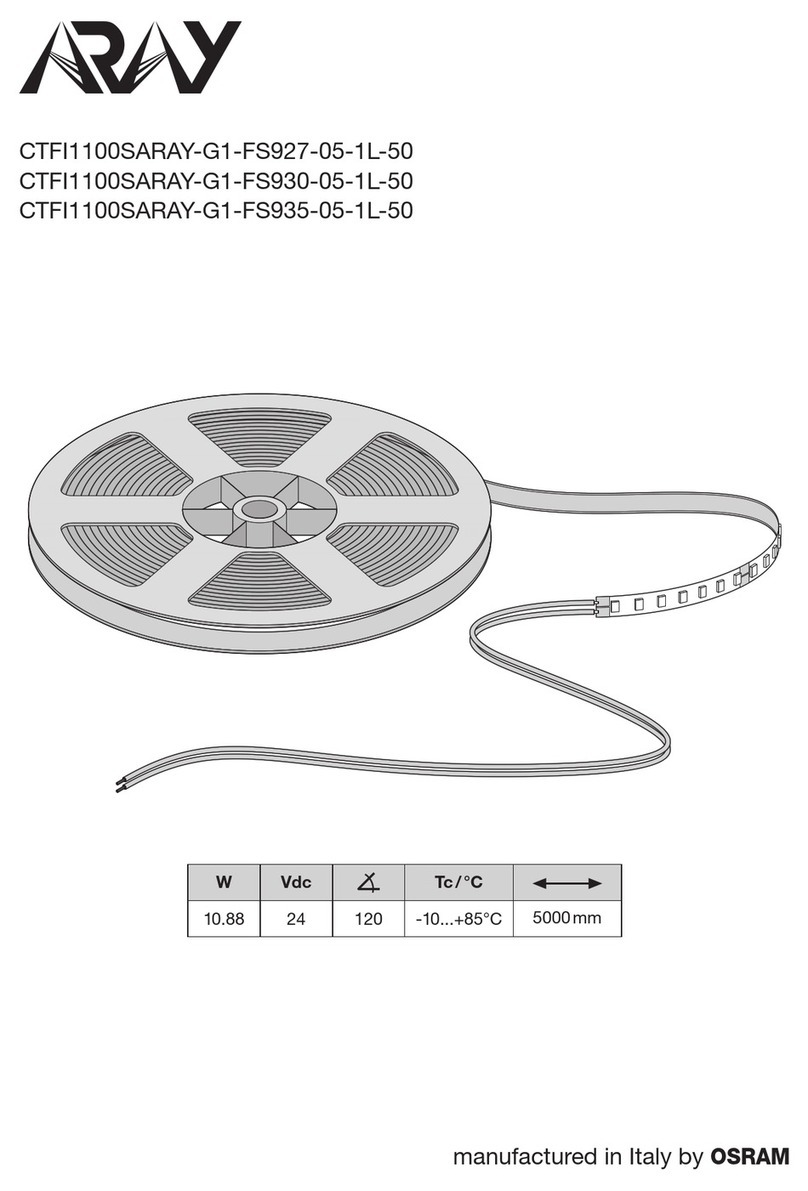
Osram
Osram ARAY CTFI1100SARAY-G1-FS927-05-1L-50 quick start guide
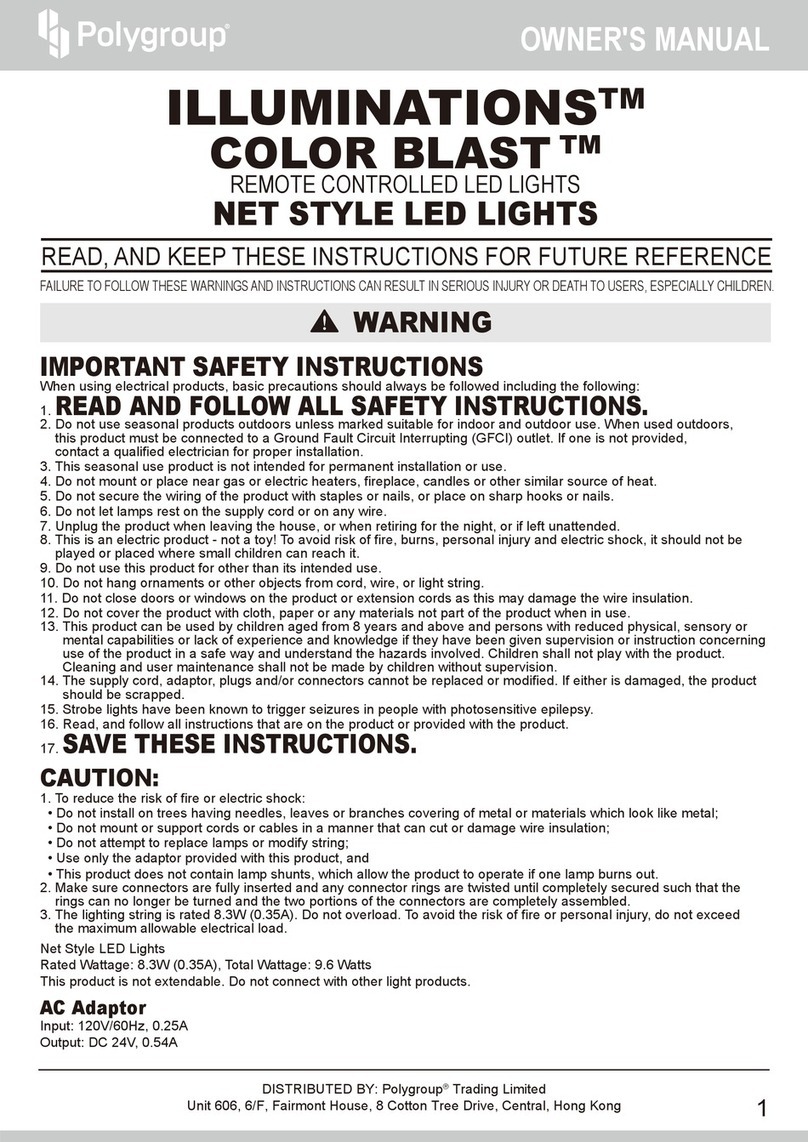
Polygroup
Polygroup ILLUMINATIONS COLOR BLAST NET STYLE LED... owner's manual
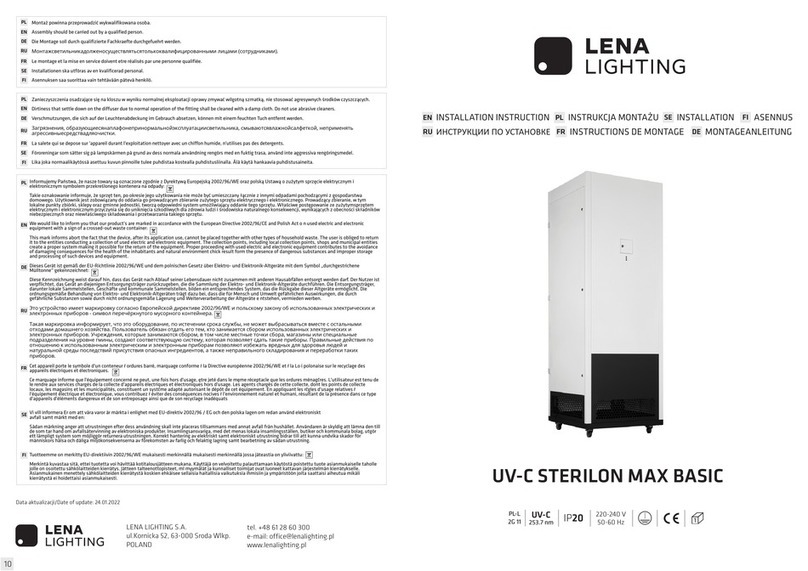
Lena Lighting
Lena Lighting UV-C STERILON MAX BASIC Installation instruction
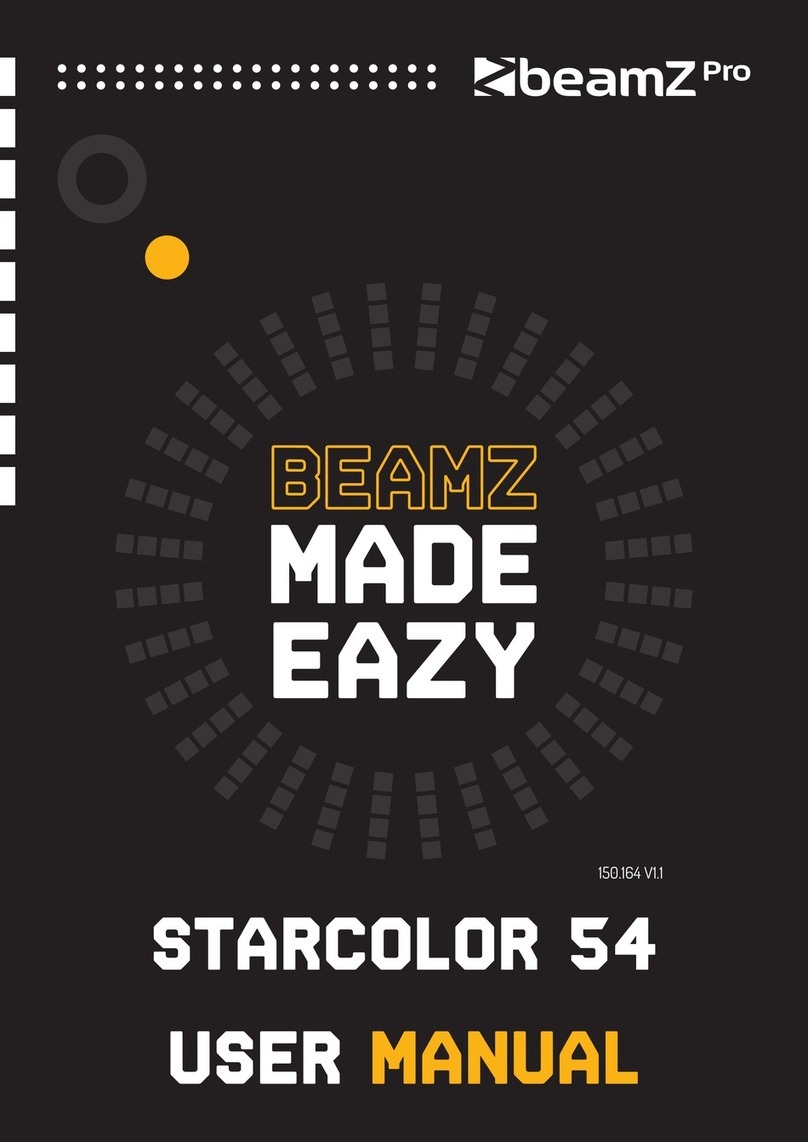
Beamz Pro
Beamz Pro Starcolor 54 user manual
